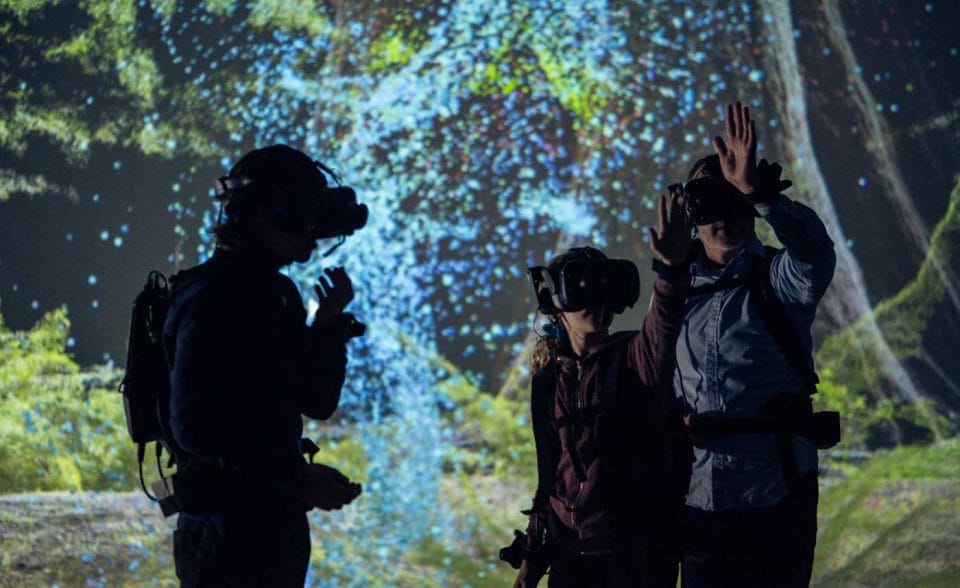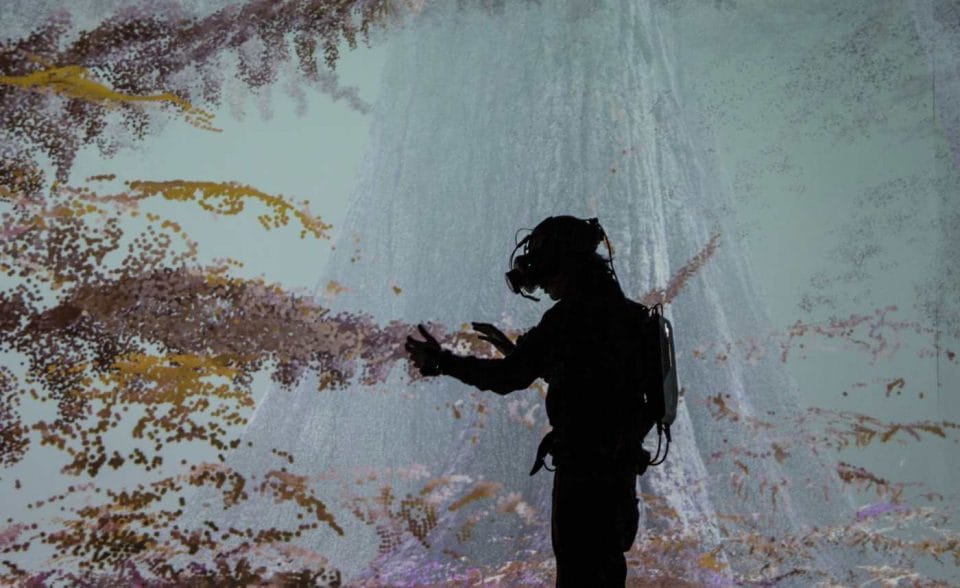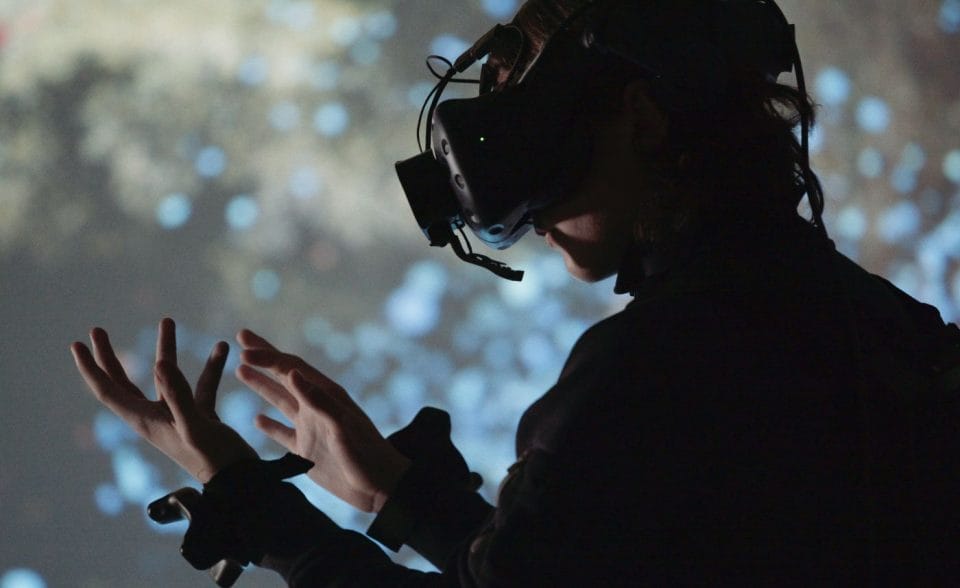
Photo credit Marshmallow Laser Feast
At the intersection of sustainability, reel and real life, and the magic of the digital realm lies We Live in an Ocean of Air, an exhibition by London-based immersive art collective Marshmallow Laser Feast (we’ll let Creative Director Ersin Han Ersin who’s pictured above explain the name in a bit) that’s showcasing at the Artscience Museum.
Here, Ersin himself takes us through the exhibition and how you can connect with nature today, one VR goggle experience at a time.
Hi Ersin, how’s it going?
Thank you! I’m having an excellent time in Singapore where I’ve already visited both primary forests as well as parks and gardens, where I met some magnificent members of flora.

Photo credit Marshmallow Laser Feast
I’d like to start off this interview by asking about the name of the studio: Marshmallow Laser Feast. It’s kind of cute, like Random Penguin House but what relevance does the word ‘Marshmallow’ have to your works?
It is totally random. In retrospect, it fits nicely with our fantasy worlds and also speaks to all senses.
View this post on Instagram
Now, about the work itself. I usually like to get first-time interviewees to “elevator pitch” their business in 10 words so if you could humour me.
We Live in an Ocean of Air is a mixed reality experience highlighting the interconnectedness between humans and trees through respiration.

Photo credit Marshmallow Laser Feast
Reading the gist of We Live in an Ocean of Air makes it seem like it meets in the middle of education and entertainment: how did the idea start for you?
You are quite spot on – our aim with the project is to make people fall in love with the natural world, and foster a feeling of familiarity with something so different from themselves such as a giant redwood tree.
The idea came to us during a visit to Sequoia National Park in California where we met the giant redwoods for the first time. It is a humbling experience to stand in front of a tree that’s at least 10 stories high and has been rooted there for thousands of years.
We wanted to capture that moment of awe and expand on it by creating this experience.
View this post on Instagram
I’m also assuming that there’s a ton of research that has to be done, so how did you start? What was one fact found in your research that you think is the main messaging of We Live in an Ocean of Air?
Indeed, we’ve worked with Salford University and Eden Project’s science team to understand the inner workings of these trees. We also conducted our own research where we scanned through an extensive literature of books, papers, and research articles to provide scaffolding for the narrative.
The main concept that drove the narrative is the exchange of oxygen and carbon dioxide between animals and plants as respiration plays such an important role for life on earth.
View this post on Instagram
Actually, I have to ask: what does the exhibition’s name mean?
The name of the installation was derived from the writings of Evangelista Torricelli who wrote “We live submerged at the bottom of an ocean of air” in 1644. He studied the composition of the earth’s atmosphere and the different gases that make up our blue skies, coming up with the early theories of how air moves between different regions of the earth.
There is a saying: ‘Fish don’t know they’re in water”. In the same vein, we often forget that we are alive because of the air we breathe. In highlighting this, we can then ask – Ok, where does air come from? What does it involuntarily connect us to?
By provoking contemplation on something obvious yet difficult to comprehend, we are hoping to highlight our invisible connection with the wider systems of nature through respiration and the air we breathe in and out thousands of times a day.
I’m not sure if you’ve watched Love, Death & Robots but there’s an episode that at the end of it, portrays humans as pests and insectoids as the natural occupants of the planet. How does We Live in an Ocean of Air celebrate humanity’s relationship with the planet then?
Humans have been walking on this planet for a very long time, with many indigenous cultures building a mutually beneficial and respectful relationship with their habitats and inhabitants. The disconnect with the natural world and seeing humans above all living beings is a new concept that coincides with the era of enlightenment and onwards.

While it cumulated in a great deal of progress that enriched our lives (some more than others), we came to forget this invisible connection. We Live in an Ocean of Air aims to remind us that our collective future depends on us understanding our interconnectedness with the natural world, and for that, it is crucial to contemplate our ties to the more-than-human world.
Bringing the invisible into view and exploring the symbiosis of everything can transform not only our understanding of the world but how we interact with it.
View this post on Instagram
I feel like the exhibition transcends age groups, economic backgrounds, and intellectual levels. Everybody can just go there, experience it, and not feel “victimised” by it or wonder what’s going on. Do you think perhaps, that’s some kind of a new-age approach to exhibitions?
You’ve captured our aim quite well here. But I think both of these approaches are essential. For us, it’s very important to create a space that invites everyone, whether you are a climate denier, climate activist, or are completely neutral towards nurturing nurture a new type of relationship with the more-than-human world – a relationship that is built on utmost care, mutual respect and most importantly, love.

However, this approach doesn’t discount the importance of a firm conversation with the audience through a factual and nuanced call to action which other forms of exhibitions can deliver successfully. Both of these approaches are important in evoking a sense of urgency since we don’t have much time left to act on reversing the catastrophic effects of climate change.
What has the general response been like since the exhibition launched in 2019? And most importantly, why Singapore?
We’ve received overwhelmingly positive feedback from the audience in London, where the installation was extended twice due to the popular demand. It was surprising for us that visitors came to see the natural world through an experiential and technologically advanced lens.
We had been in conversations with the team at ArtScience museum for a few years to bring We Live in an Ocean of Air to Singapore. But due to the pandemic, we had to pause before finally continuing our collective efforts this year.
Singapore has been playing an important role as a cultural bridge between the East and the West for a very long time. ArtScience Museum’s curatorial programming and nuanced engagement with their global audience made the decision to house our installation there very easy for us. Singapore’s approach to building a City in a Garden encourages to have a new type of conversation between humans and nature.
This nuanced nature-culture dialogue will offer new insights for us and we are aiming to distill these learnings back into how we present We Live in an Ocean of Air in Asia and beyond.
Lastly, out of curiousity, what was your #1 song on your Spotify list last year?
Gravity that Binds – Caterina Barbieri.








